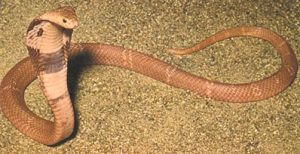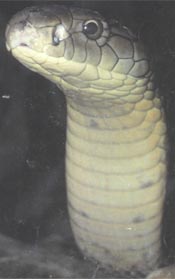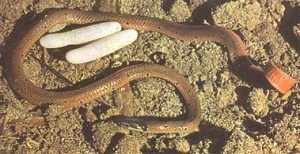|
The Indian (Monocled) Cobra – Naja naja kaouthia |
|
Distinctive Features: Medium-sized; smooth, shiny scales; wide head and neck; distinctive hood marking different from that of the spectacled cobra. Description: The skin of the Monocled Cobra is shinier, the hood rounder and smaller and the head smaller than is that of the spectacled cobra. The colour varies widely, from yellowish to greenish brown to black, with ragged bands. There is a conspicuous white monocle on the hood. The underside is yellowish white Monocled Cobras superficially resemble Spectacled Cobras, but there are many small differences. Distribution: Monocled Cobras are a sub-species most commonly found in northwest India, parts of Uttar Pradesh, Bihar, Orissa and the Andamans, all of Bengal and Assam. |
|
Russells Viper – Vipera russellii |
|
Distinctive Features: Medium-sized to large; strongly keeled scales; distinctive bright chain pattern; large triangular head. Description: Russells Vipers are heavy, rough-scaled snakes with vertical eye pupils and generally a very bright pattern. The body colour is usually brown or yellowish and the pattern is composed of dark, round spots edged with white and black. The underside is white in the western, partly speckled in the southeastern and heavily speckled in the northeastern race. Colour variation is common, and the best recognition characters are the short, fat body, the triangular-shaped head and very regular chain like pattern. Russells vipers resemble the fat, harmless common sand boas which however have shorter and blunter tails and irregular body patterns. The bright symmetrical spots on Russells Viper’s backs make them easy to differentiate. Russells Vipers are one of the big Four dangerous snakes of India. The other large Indian viper is the Levantine Viper, a heavy brown snake found in parts of Kashmir which grows to 11/2 m. Distribution: Hills and plains throughout India upto 3,000 m. |
|
Saw-Scaled Viper – Echis carinatus |
|
Distinctive Features: small; strongly keeled scales; head wider than neck; dull colour; cross mark on top f head distinctive. Description: A rough scaled snake with large eyes, wider head than neck and stocky body. The scales are heavily keeled. The body is brown, grayish or sandy with a darker zigzag pattern on the back and a distinct cross or lance mark on the head. The underside is white with brown speckles. The tail is short and stubby. Saw-scaled Vipers are the smallest of the Big Four venomous snakes and are less of the threat to man in South India because of the small size of the southern type. The northern for, however, grows large enough to be a potentially dangerous member of the Big four. Distribution: Throughout India, mostly on the plains. In northwest India, Saw-scaled Vipers are reported from upto 2000m ion the hills. They are plentiful in certain area such as Ratnagiri District in Maharashtra, parts of Punjab, Rajasthan, Tamil Nadir and Andhra Pradesh. |
|
Common Krait – Bungarus caeruleus |
|
Distinctive Features: Medium-sized; smooth, glossy scales; head slightly wider than neck: jet-black, usually with distinct white cross lines. Description: Common Kraits are smooth, glossy bluish-black snakes with the rounded head slightly distinct from the neck. The body colour varies from a dark steely blue-black in a specimen which has freshly shed its skin to a pale faded bluish grey in one just about to shed. There are normally about 40 thin white cross bands. The young and some adults may have white spots along the first third of the backbone in place of the cross lines. This variation as well as uniform black variants appear in certain geographic races. The underside is white. Common Kraits are often confused with wolf snakes (Lycodon sp.) which are much smaller, with flat, somewhat pointed heads. The Common Krait is the best known of the 6 Krait species found in India and one of the big Four dangerous snakes. Besides the Common and Banded Krait, the other krait are rare and confined to the eastern Himalayas and Assam. Distribution: Most of India including the Andaman and Nicobar Islands: sea level up to 1700 m. uncommon in Bengal, Assam and Orissa, where the Banded Krait is found |




